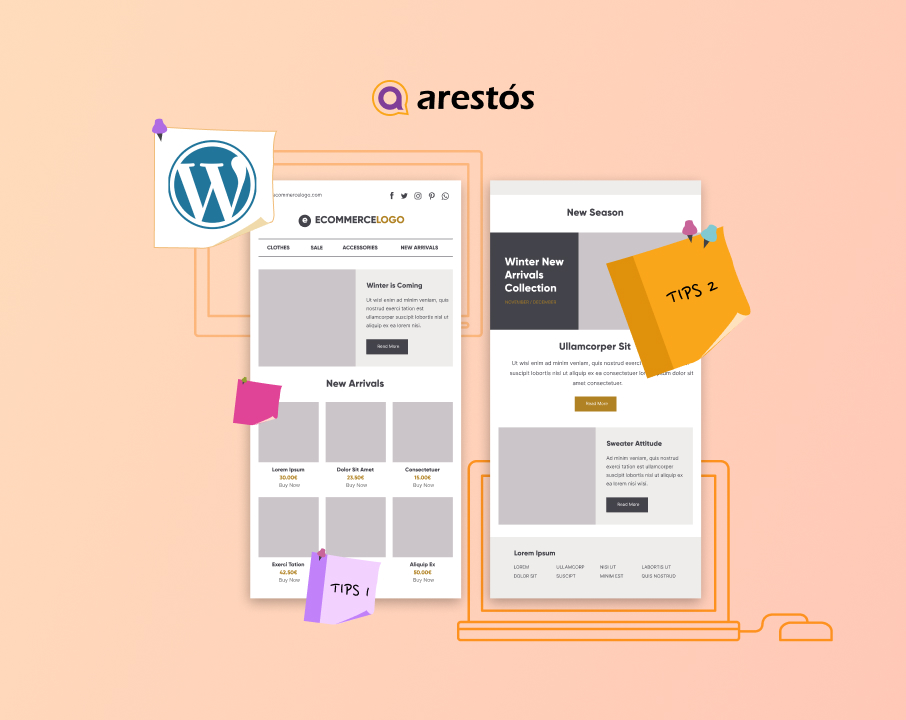Tips for Creating a User-Friendly Shopping Experience with WordPress E-commerce Templates
In the digital age, providing a user-friendly shopping experience is vital for online businesses. With the increasing popularity of WordPress e-commerce templates, businesses can leverage these powerful tools to enhance the user experience on their online stores.
In the digital age, providing a user-friendly shopping experience is vital for online businesses. With the increasing popularity of WordPress e-commerce templates, businesses can leverage these powerful tools to enhance the user experience on their online stores. In this blog post, we will explore essential tips for creating a user-friendly shopping experience using WordPress e-commerce templates.
Design Considerations for User-Friendly Shopping Experience:
Mobile responsiveness and compatibility:
To cater to the growing number of mobile shoppers, ensure that your WordPress e-commerce template is mobile-responsive and compatible across different devices and screen sizes. This allows users to browse and make purchases seamlessly on their smartphones or tablets.
Intuitive and easy-to-navigate layout:
A clutter-free and intuitive layout is crucial for guiding visitors through your online store. Implement clear navigation menus and ensure that product categories are easily accessible. Intuitive navigation improves user engagement and encourages exploration of your product offerings.
Clear and prominent calls-to-action (CTAs):
Use visually appealing and prominent CTA buttons to guide users towards desired actions, such as “Add to Cart” or “Buy Now.” The CTAs should stand out from the rest of the page and be strategically placed to capture users’ attention.
Consistent branding and visual elements:
Maintain a consistent brand identity throughout your online store by incorporating your logo, color scheme, and typography. Consistency creates a cohesive and professional look, instilling trust and familiarity in your customers.
Optimized product search and filtering options:
Implement an efficient search functionality that allows users to find products quickly. Additionally, provide filtering options based on categories, price ranges, and other relevant attributes to help users narrow down their search results.
Click here to explore more WordPress e-commerce templates by Arestos.
Optimizing speed and performance is crucial for a WordPress e-commerce templates:
Importance of fast-loading pages:
Slow-loading pages frustrate users and lead to high bounce rates. Optimize your WordPress e-commerce template by minimizing unnecessary code, compressing images, and leveraging caching techniques to ensure fast-loading pages.
Minimizing image and file sizes:
Compressed and optimized images contribute to faster page loading times. Use image compression tools or plugins to reduce file sizes without compromising quality. Additionally, minify CSS and JavaScript files to further enhance performance.
Caching and content delivery network (CDN) integration:
Implement caching mechanisms and leverage a CDN to deliver static content from servers located closer to the user’s geographical location. Caching and CDN integration significantly improve page load times, resulting in a smoother shopping experience.
Streamlining checkout process for quicker transactions:
Simplify the checkout process by minimizing the number of steps required to complete a purchase. Implement a guest checkout option to eliminate the need for users to create an account, reducing friction and increasing conversions.
Simplifying Product Discovery and Selection:
Clear product categorization and hierarchy:
Organize your products into logical categories and subcategories to help users navigate and find what they’re looking for easily. Clear product categorization improves the overall user experience and encourages browsing.
Comprehensive product descriptions and specifications:
Provide detailed and accurate product descriptions, including specifications, features, and benefits. This helps users make informed purchasing decisions and reduces the likelihood of product returns.
High-quality product images and videos:
Use high-resolution images and, if applicable, include product videos to showcase your offerings from different angles. High-quality visuals provide users with a better understanding of the product and enhance their trust in your brand.
Related product recommendations and cross-selling opportunities:
Implement a recommendation engine that suggests related products or cross-sells based on users’ browsing and purchasing history. This encourages users to explore additional products and increases the average order value.
Tips for Streamlining the Checkout Process to Create a User-Friendly Shopping Experience with WordPress E-commerce Templates.
Guest checkout option for frictionless purchases:
Offer a guest checkout option that allows users to make a purchase without creating an account. This reduces barriers to entry and provides a seamless checkout experience for first-time buyers.
Simplified and intuitive shopping cart functionality:
Optimize your shopping cart design to be user-friendly, displaying clear product information, quantities, and pricing. Include a prominent “Checkout” button and provide users with the option to edit their cart contents easily.
Multiple payment gateways and secure payment processing:
Integrate popular payment gateways to offer a variety of payment options to your customers. Ensure that your WordPress e-commerce template supports secure payment processing to build trust and protect sensitive customer information.
Transparent shipping options and costs:
Clearly display shipping options, estimated delivery times, and associated costs upfront. Avoid surprising users with additional shipping charges during the checkout process, as this can lead to cart abandonment.
Order confirmation and tracking information:
Send order confirmation emails to customers immediately after a purchase is completed. Provide tracking information and regular updates on the status of their order to keep them informed and engaged.
Integration of User Reviews and Social Proof:
Displaying customer reviews and ratings:
Showcase customer reviews and ratings for products to build trust and credibilityamong potential buyers. Positive reviews and ratings serve as social proof, influencing purchasing decisions.
Implementing social sharing buttons:
Incorporate social sharing buttons to allow users to share products they like on social media platforms. This not only promotes your products but also increases brand visibility and attracts potential customers.
Showcasing testimonials and success stories:
Feature testimonials and success stories from satisfied customers on your website. Testimonials provide social proof and demonstrate the positive experiences others have had with your products, further instilling confidence in potential buyers.
Leveraging Analytics and User Insights:
Utilizing website analytics tools:
Integrate website analytics tools, such as Google Analytics, to gain insights into user behavior, traffic sources, and conversion rates. Analyzing this data helps identify areas for improvement and make data-driven decisions.
Analyzing user behavior and conversion paths:
Analyze user behavior, such as click-through rates, time spent on pages, and shopping cart abandonment rates. Identify bottlenecks in the user journey and optimize those areas to improve conversions.
Making data-driven improvements to enhance the shopping experience:
Use data insights to make informed improvements to your WordPress e-commerce template. Test different layouts, CTAs, and product presentation to optimize user experience and increase conversions.
Testing and Iteration for Continuous Improvement:
Conducting A/B testing for different elements:
Implement A/B testing to compare different versions of your website, such as layouts, colors, and CTAs. This helps identify the most effective design elements and optimize the user experience accordingly.
Gathering user feedback and making iterative changes:
Encourage users to provide feedback through surveys, polls, or contact forms. Listen to their suggestions and pain points to make iterative changes that address their needs and preferences.
Staying updated with the latest UX/UI trends and best practices:
Stay informed about the latest UX/UI trends, industry best practices, and emerging technologies. Regularly update your WordPress e-commerce template to incorporate new features and design elements that enhance the shopping experience.
Conclusion:
Creating a user-friendly shopping experience is crucial for online businesses to attract and retain customers. By implementing the tips outlined above and leveraging the power of WordPress e-commerce templates, you can optimize your online store for a seamless and enjoyable shopping journey. Continuously analyze user behavior, gather feedback, and make iterative improvements to provide a user experience that delights customers and drives business success.
Remember, choosing the right WordPress e-commerce template is key to implementing these tips effectively. Explore the vast array of WordPress e-commerce templates available, ensuring they align with your brand and provide the necessary features for a user-friendly shopping experience.
With the right combination of design, performance optimization, product presentation, and user feedback, your online store can stand out and provide a top-notch shopping experience that keeps customers coming back for more.
If you need advice on WordPress e-commerce templates, don’t hesitate to contact Arestós. Our team of experienced experts in WordPress e-commerce will provide consultation to help you make the best choice for your online store.



